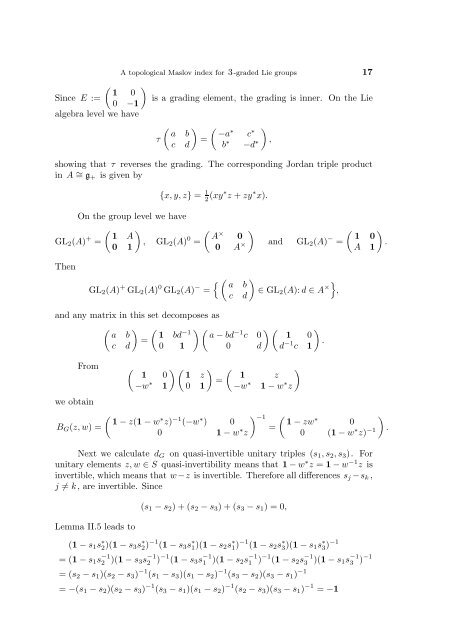A topological Maslov index for 3-graded Lie groups - ResearchGate
A topological Maslov index for 3-graded Lie groups - ResearchGate
A topological Maslov index for 3-graded Lie groups - ResearchGate
You also want an ePaper? Increase the reach of your titles
YUMPU automatically turns print PDFs into web optimized ePapers that Google loves.
A <strong>topological</strong> <strong>Maslov</strong> <strong>index</strong> <strong>for</strong> 3-<strong>graded</strong> <strong>Lie</strong> <strong>groups</strong> 17<br />
<br />
1<br />
Since E :=<br />
0<br />
<br />
0<br />
is a grading element, the grading is inner. On the <strong>Lie</strong><br />
−1<br />
algebra level we have<br />
<br />
a<br />
τ<br />
c<br />
<br />
∗ b −a<br />
=<br />
d<br />
c∗ b∗ −d∗ <br />
,<br />
showing that τ reverses the grading. The corresponding Jordan triple product<br />
in A ∼ = g+ is given by<br />
On the group level we have<br />
GL2(A) + =<br />
Then<br />
1 A<br />
0 1<br />
{x, y, z} = 1<br />
2 (xy∗ z + zy ∗ x).<br />
<br />
, GL2(A) 0 =<br />
GL2(A) + GL2(A) 0 GL2(A) − =<br />
and any matrix in this set decomposes as<br />
<br />
−1<br />
a b 1 bd<br />
=<br />
c d 0 1<br />
we obtain<br />
<br />
× A 0<br />
0 A ×<br />
<br />
and GL2(A) − =<br />
<br />
a b<br />
∈ GL2(A): d ∈ A<br />
c d<br />
×<br />
<br />
,<br />
a − bd −1 c 0<br />
0 d<br />
<br />
1 0<br />
d−1 <br />
.<br />
c 1<br />
From <br />
1 0<br />
−w∗ <br />
1 z 1 z<br />
=<br />
1 0 1 −w∗ 1 − w∗ <br />
z<br />
BG(z, w) =<br />
<br />
1 0<br />
.<br />
A 1<br />
<br />
∗ −1 ∗ 1 − z(1 − w z) (−w ) 0<br />
0 1 − w∗ −1 <br />
∗ 1 − zw 0<br />
=<br />
z 0 (1 − w∗z) −1<br />
<br />
.<br />
Next we calculate dG on quasi-invertible unitary triples (s1, s2, s3). For<br />
unitary elements z, w ∈ S quasi-invertibility means that 1 − w ∗ z = 1 − w −1 z is<br />
invertible, which means that w −z is invertible. There<strong>for</strong>e all differences sj −sk ,<br />
j = k, are invertible. Since<br />
Lemma II.5 leads to<br />
(s1 − s2) + (s2 − s3) + (s3 − s1) = 0,<br />
(1 − s1s ∗ 2 )(1 − s3s ∗ 2 )−1 (1 − s3s ∗ 1 )(1 − s2s ∗ 1 )−1 (1 − s2s ∗ 3 )(1 − s1s ∗ 3 )−1<br />
= (1 − s1s −1<br />
−1<br />
2 )(1 − s3s2 )−1 (1 − s3s −1<br />
−1<br />
1 )(1 − s2s 3<br />
= (s2 − s1)(s2 − s3) −1 (s1 − s3)(s1 − s2) −1 (s3 − s2)(s3 − s1) −1<br />
1 )−1 (1 − s2s −1<br />
= −(s1 − s2)(s2 − s3) −1 (s3 − s1)(s1 − s2) −1 (s2 − s3)(s3 − s1) −1 = −1<br />
)(1 − s1s −1<br />
3 )−1

















